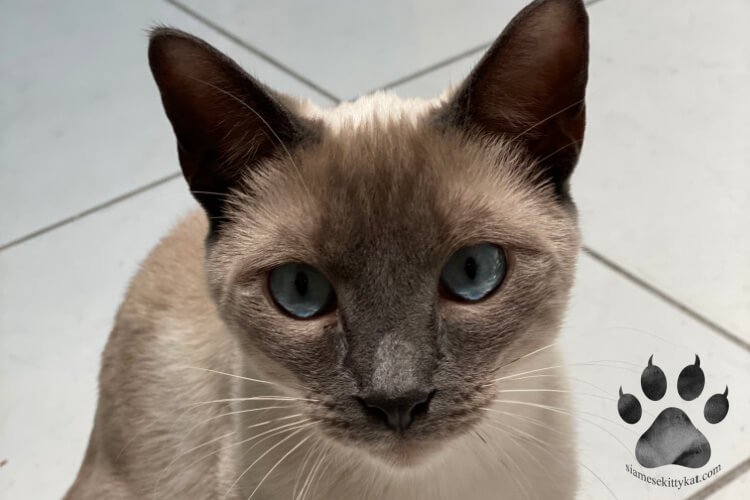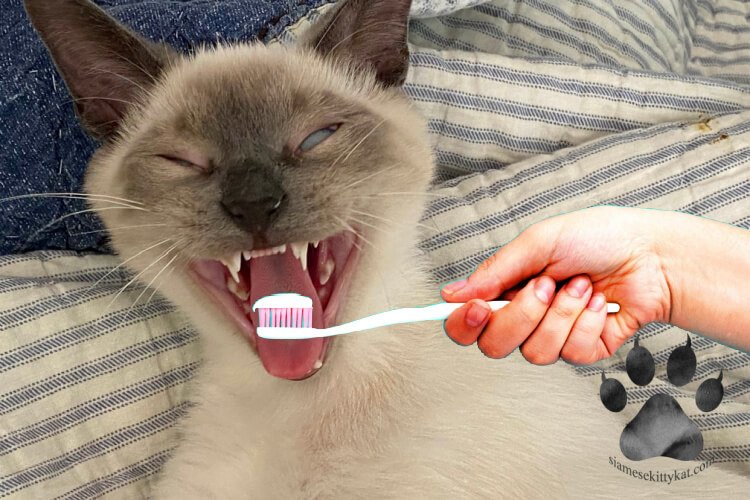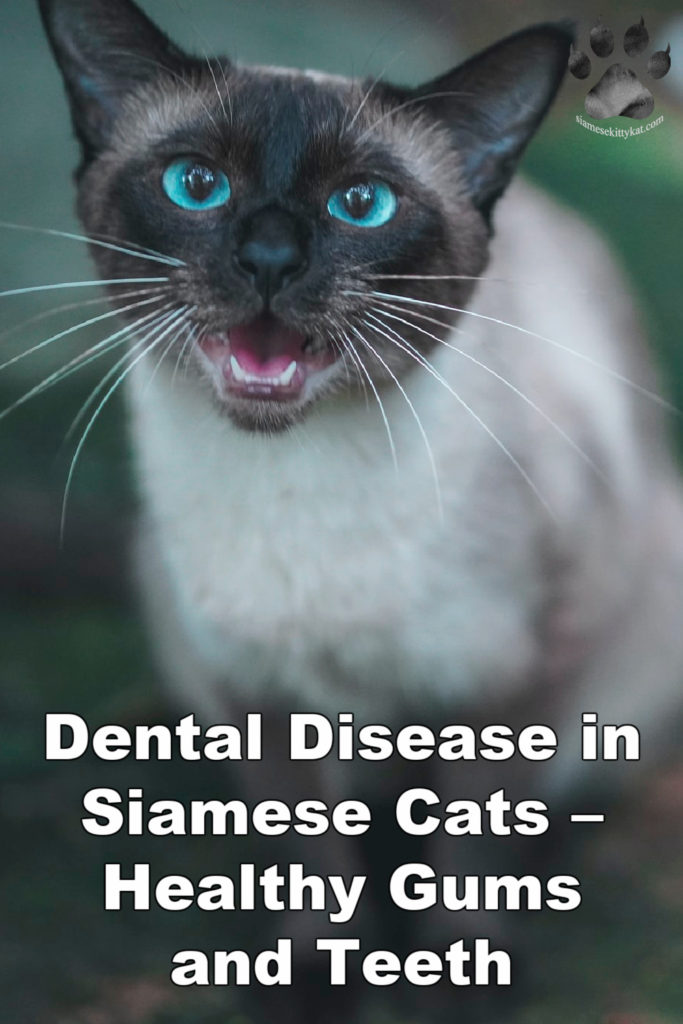Siamese cats love to vocalize their opinions, play until the sun comes up, and love you for all their eternity. A great way to repay this love is to take care of them and ensure they’re always healthy and thriving.
Did you know, over 70% of cats over the age of 4 experience some sort of dental disease? Siamese cats are no different – in fact, they’re prone to dental disease more than your regular moggie.
In this article, we’re going to dive into everything about dental disease. Keep on reading to figure out the best way to keep your Siamese’s teeth shiny and healthy!
What are the signs of dental disease In cats?
Since Siamese kitties demand so much attention, you may believe you know them better than themselves. However, it is actually quite challenging to know when our pets are sick – especially cats.
Even though cats have been domesticated to the point of happily living with us humans, they still have their natural instincts. In the wild, cats are often preyed upon. To hide their vulnerability, they will never show their weakness or the fact they are sick.
Although this can make it quite difficult for owners to determine whether or not their feline is in pain, there are a few clues to look out for:
If your Siamese is suffering from dental pain they’ll only eat when they’re very hungry. Once they finally eat, they’ll more than likely vomit up the food. Some cats may show signs of wanting to eat, but chewing is just too painful for them.
If your Siamese has ever licked you, you’ll notice how rough their tongue is. They have little barbs called papillae lining their tongue and they use them to groom themselves.
When your Siamese is experiencing dental pain, they’ll eat their food using only their tongue and not their teeth. This will cause food to build up inside their stomach which then results in vomiting after they eat.
Cats with a painful mouth may refuse to eat dry food due to pain and only show a preference to wet or soft food. Many owners often dismiss the signs of dental disease, thinking their Siamese is just being a finicky eater. The reluctance to eat may lead to rapid weight loss.
What are the most common dental diseases in cats?

There are 3 common dental diseases known in cats: periodontitis, gingivitis, and tooth resorption. Each of these conditions can vary in severity and like most diseases, are much more treatable when identified quickly.
Gingivitis
If your Siamese has swollen, red gums, chances are they’re suffering from gingivitis. Gingivitis develops when plaque is allowed to build upon the teeth. Eventually, the bacteria in the plaque will migrate towards the base of the tooth, causing the redness and swelling we call gingivitis.
When the plaque on the teeth hardens, it then turns into tartar. Tatar causes the teeth to become rough on the surface, allowing bacteria to easily attach to them. The bacteria that attaches itself to the tartar is what causes the inflammation and redness.
Gingivitis can also be triggered by a range of other diseases such as:
If gingivitis has been brought on by any of these diseases, your Siamese may develop a condition called stomatitis.
Signs Of Gingivitis
Depending on the severity of the felines gingivitis, your Siamese could show any of these signs:
Preventing Gingivitis
Just like us humans, the best way to prevent any sort of dental disease is by brushing the teeth often. You can find many types of toothpaste and brushes designed specifically for cats – you should never use products designed for humans as they could be toxic.
If your Siamese is suffering from a severe case of gingivitis, brushing their teeth could be quite painful for them. Therefore, you should always consult a vet to get advice on how to move forward.
Treating Gingivitis
Thankfully in most cases, treating gingivitis is quite straightforward and reversible. Depending on how far the gingivitis has developed and how will help determine which treatment is given.
Treatments include:
Periodontitis
When gingivitis is left untreated, it’ll develop into a condition called periodontitis. Unlike gingivitis, periodontitis can not be reversed.
If your Siamese has developed periodontitis, the tissues that attach the gum and teeth together begin to weaken due to bacteria and inflammation. When the tissue has weakened, it may lead to tooth loss.
9 times out of 10, gingivitis is the leading cause of periodontitis – so it is important it is treated once identified.
Signs Of Periodontitis
Since periodontitis is usually the result of gingivitis, they both have similar signs:
Treating Periodontitis
In order to evaluate periodontitis, your Siamese will have to undergo an X-ray of the jaw, which requires them to go under anesthesia.
Treatment, depending on the level of periodontitis, may include:
Tooth Resorption
Tooth resorption is the leading cause of tooth loss in cats. If your Siamese is suffering from this dental disease, the tooth structure begins to break down, progression from inside the tooth to other parts of the teeth. Eventually leading to tooth loss if not treated.
Over 50% of cats show signs of this disease, with the cause still unknown.
Signs Of Tooth Resorption
Tooth resorption can be a very painful dental disease. By the time the disease has been identified, it is usually already significantly damaged. Vets will check for a pink line along the gums which can vary in size and severity.
Signs your Siamese may be suffering from tooth resorption include:
For tooth resorption to be identified, your Siamese will have to go under anesthesia to receive an X-ray of the jaw and head.
Treating Tooth Resorption
In cases where the tooth is causing the feline too much pain and it is beyond repair, your vet will suggest removing the tooth. In milder cases, your vet will treat your cat’s tooth pain and attempt to stop the disease from progressing any further.
Either way, close monitoring after the fact is very important to ensure the disease doesn’t develop further.
What is feline stomatitis?

Technically speaking, stomatitis translates to inflammation (itis) of the cavity (stoma). When referring to dental disease, stomatitis affects the oral cavity, causing pain and inflammation.
Stomatitis is quite a complicated disease and not much is known about it. We do know, however, that it is essentially the immune system attacking itself. When a buildup of plaque occurs, the body creates inflammation as a reaction. This results in pain all around the mouth.
Treating Stomatitis
Since there is a lack of knowledge about stomatitis and how it comes about, it gets quite difficult to treat. Many felines are given medication as a way to ease the pain, however, antibiotics will not stop the disease from developing.
Scaling and cleaning the teeth professionally may help in some cases, but usually, this will not be enough to stop the plaque from accumulating. The more plaque that accumulates, the worse the stomatitis will become.
Since there isn’t an effective treatment available for our felines, stomatitis usually ends with most, if not all, teeth being extracted. Taking out all the teeth may seem extreme, however, it will vastly improve how your Siamese is feeling even the same day of the surgery.
Think of it this way: would you rather have no teeth, or a mouth full of painful sores that makes it impossible to eat? Your Siamese may look a little funny missing some teeth, but they’ll feel better for it!
How does a cat eat without teeth?
Now, you may be wondering how a toothless cat even eats. Chances are if your Siamese is suffering from dental disease, they’re currently not using their teeth anyway. They’ll much rather swallow the food whole than crunch it on their painful gums.
Many cats return home after surgery and end up eating a full bowl of food without any problems. There will be a healing period where your Siamese will be limited to wet food, however, after this, they can go back to eating dry food.
Since the pain and inflammation will be gone with the teeth, most cats recover without any problems.
How to prevent dental disease in cats?
Once your Siamese has gone past the gingivitis stage, the effects of dental disease become irreversible. That’s why it’s incredibly important to prevent these diseases from developing in the first place.
When your Siamese is still a kitten, it is important to familiarize them with a toothbrush and regular dentist check ups.
Ensure you include all of the following in your Siamese cats dental care:
When should i brush my cat’s teeth?

While it’s recommended for us humans to brush our teeth twice a day, for your Siamese it should be once a day. Daily brushing significantly decreases the chance of plaque and tartar buildup.
If your Siamese is not used to having their teeth brushed, it may be a hard process to get them acquainted. That’s why it’s recommended to teach your Siamese to accept brushing while they’re still a kitten.
Establishing a routine will help when it comes to daily brushing. If you’re unable to brush their teeth daily, a minimum of 3 times a week is needed.
How do I brush my cat’s teeth?
It is always important to make your Siamese feel safe when you brush their teeth. This way, it’ll be a positive experience for both of you!
For successful brushing, follow these steps:
What toothbrush should I use on my cat?
If you take a trip to your local pet store or vet, you’ll find a bunch of toothbrushes on offer. These include:
Some owners used soft toothbrushes designed for human babies, however, it is much better to use one specifically designed for cats. If you’re having trouble with a toothbrush that has a handle, a finger brush may be better for you.
If your Siamese hasn’t got past the Q-tip stage yet, you can continue using it until they feel comfortable to move onto something else.
If you’re unsure which toothbrush is right for your Siamese, you can always consult your vet for advice. It is best to find a brush that is able to reach just below the gumline.
Either way, always be gentle when brushing your kitties’ teeth. Aggressive brushing will only cause pain and irritation.
How do I keep my Siamese’s gums healthy?
There are quite a few ways you can ensure your Siamese stays healthy when it comes to their teeth. Daily brushing, regular dental checkups, and professional cleaning when needed will all help keep plaque and tartar at bay.
If your Siamese is suffering from gingivitis, it is essential you get their teeth treated before it can develop into something much more serious.
At the end of the day, teeth are just as important to cats as they are to us!
We gathered all the health tips tailored towards maintaining your Siamese cat’s optimal well-being. Check it out here: Siamese Cat Health: A Complete Guide
Get your FREE Siamese Cat 2024 Printable Calendar


